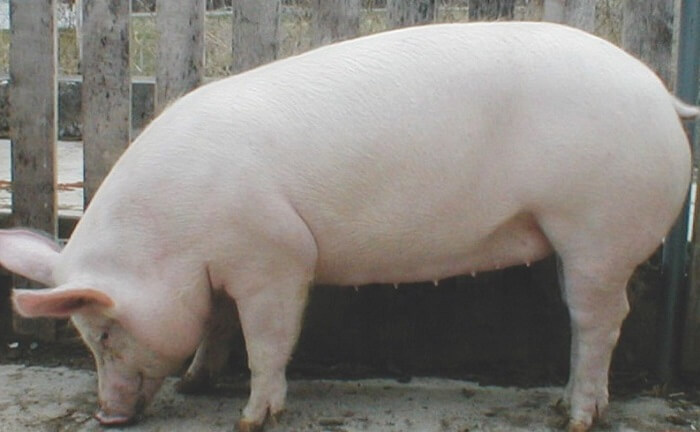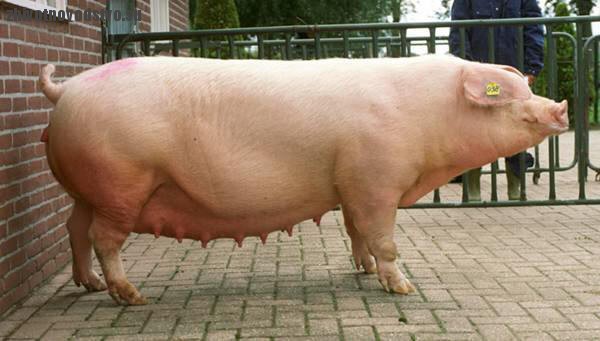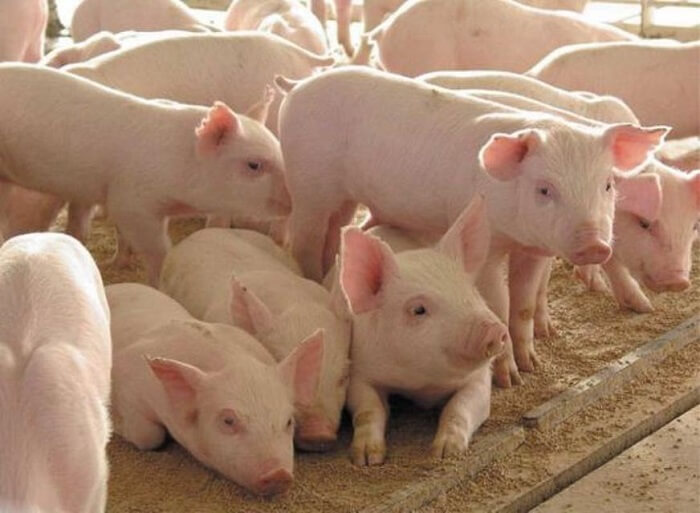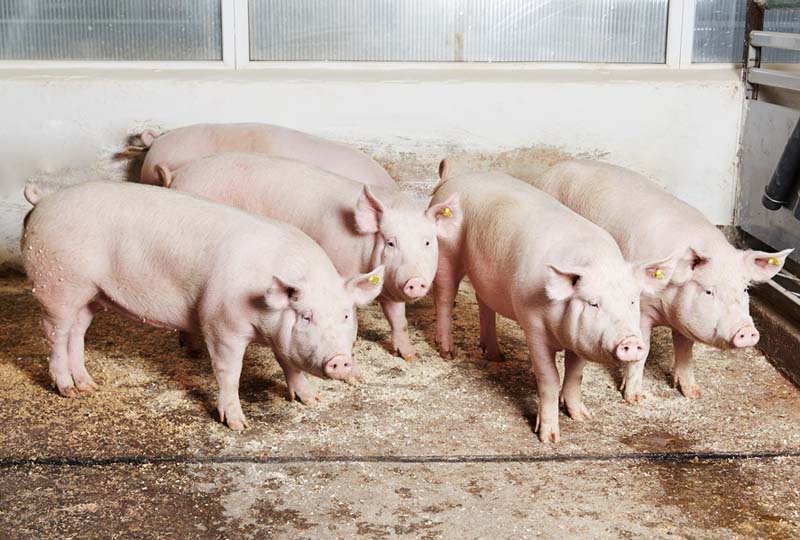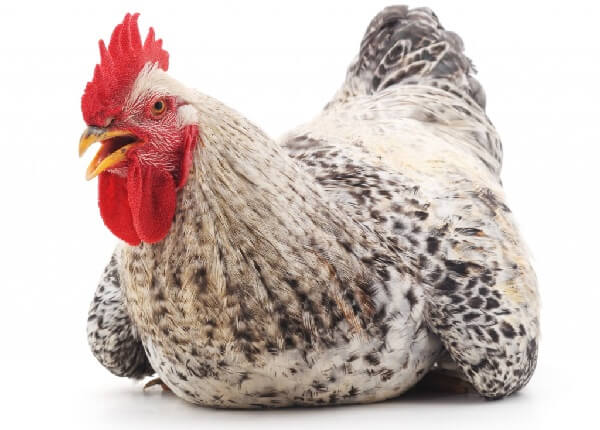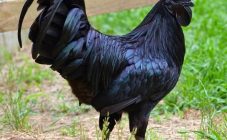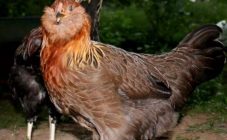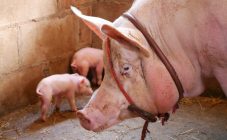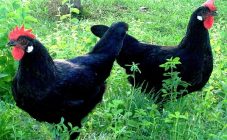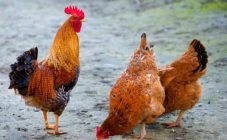Content:
Pigs are raised by farmers in many countries of the world. The benefits of breeding them are obvious - with proper maintenance and care, you can get a large amount of meat, lard, as well as a by-product - pork skins, which are used to make shoes, bags, wallets and many other things.
Naturally, farmers prefer to breed those pig breeds that are distinguished by the highest meat productivity. Therefore, this article will talk about one of these pigs - the Large White breed.
General information about the breed
The large white pig breed is incredibly popular all over the world. It was bred by breeders from Great Britain (from Yorkshire County) in the 19th century. For crossing representatives of the largest pigs were taken - local marching pigs, individuals of the Romanesque breed from Italy and Portugal, as well as Siamese pigs. At that time in England, mainly these pets with greasy productivity were raised. Therefore, the breeders were faced with the task of developing a breed that would be distinguished by meat-feeding productivity.
In the beginning, the name of the new breed was given by the name of the county where they were bred - the pigs became Yorkshire. Time passed, and this breed began to degenerate. Well-known breeders, together with breeders, developed a standard for the Yorkshire breed, breeders selected the largest males and females and began to cross the breed "in themselves", without attracting representatives of other breeds of these domestic animals. The result of their labors was the appearance of 50 boars and 60 females, fully meeting the breed standard. By the end of the 19th century, these pigs were officially named the Large White breed.
The new breed was included in the State Catalog of England, farmers from different regions of England became interested in it. Subsequently, farmers from other countries began to buy representatives of this variety. This is how the big white pig appeared in Russia. Local specialists also worked on the improvement of Large White Pigs. As a result, another branch of English pigs appeared in Russia, strikingly different from their foreign "brethren":
- in Russian individuals, the constitution of the body has become larger;
- pigs are better adapted to the harsher climate of many regions of Russia;
- females constantly bring at least 10-11 piglets.
Therefore, these pigs were named Russian large white. But the color of these pigs has remained pale pink.
The high meat productivity of this variety attracted the attention of Russian breeders, therefore, the pigs began to be used for crossing when breeding new breeds or improving the performance of existing local pigs.
In the process of selection, several new varieties of pigs were obtained, in which the positive qualities of their "parents" were noted. Representatives of white pigs and breeds bred on their basis are known not only in Russia. At present, "Russian" pigs have been bred in many countries of Europe, Asia, and also in America.
Characteristics and features of the breed
It is necessary to start the story about the Large White breed of pigs and its characteristics with the appearance of the pigs. These pigs got their name "large" for a reason.Already by the year, white piglets weigh more than 190 kg, if the necessary conditions are created for them, and the correct feeding regime is drawn up. The skin is covered with light thick bristles, the color of the skin is pale pink, without folds.
The boar grows up to 1.9 m in length, the sow - up to 1.7 m. The neck is of medium length, its thickness is slightly larger than that of other species. The main difference between white pigs is wide back, hindquarters and chest. The limbs are of medium length, strong and powerful, the hooves are wide.
A boar usually weighs at least 320 kg, a sow about 220 kg.
During one birth, a sow brings from 10 to 12 piglets, which is a high birth rate. Newborn white piglets weigh at least 1.2 kg, but by 2 months they gain about 19 kg of weight. With a properly selected diet, piglets gain daily weight up to 0.9 kg.
During the lactation period, the sow gives up to 100 kg of milk, this amount is enough to feed all newborn calves. The piglet survival rate is close to 100%. Such a high survival rate of young animals indicates their high immunity, as well as the presence of a sufficient amount of milk in the sow.
This is a brief description of the Large Russian Pigs.
Breeding features of the breed
Breeding a breed starts with choosing the right piglets. Usually young animals are acquired at two months of age. Healthy individuals of this age weigh at least 19-21 kg, they are active, move quickly along the pasture, and have an excellent appetite. But such pigs cannot stand the touch of strangers and immediately run away. If a young animal is indifferent to touch, prefers to lie quietly in the shade, it is not worth buying such an animal.
Many breeders are cunning: when selling young animals in bulk, they will certainly slip several weakened specimens into the herd. Therefore, when buying piglets in large quantities, it is also necessary to inspect each of them carefully, as when buying several pieces.
All Large White pigs are prone to obesity, so their diet is designed in such a way that the pigs gain weight, but not too fat. Therefore, all feed must be carefully balanced.
With the arrival of the warm season, pigs must be released from the premises into fenced enclosures. The walking area should be spacious enough. There you should sow greens in advance, which these pigs will gladly eat. At the same time, when preparing the aviary, it is imperative to provide a canopy under which the pigs will hide from the sun's rays and rain. The sun can cause burns on their delicate skin. Therefore, at an excessively hot time of the day, it is better to drive piglets into the room.
A sample menu for these pigs should look like this:
- compound feed;
- legumes;
- cabbage foliage;
- any fruit;
- vegetables: carrots, beets, rutabagas.
These animals need salt. Therefore, lick stones are placed near the feeders, or a teaspoon of salt is added to the crushed food. Pigs should be fed 5 times a day.
The pigsty should be clean at all times. Pig pens need to be spacious and comfortable. The litter should be dry, especially for sows with newborn piglets.
You should also provide for good ventilation in the room, in the complete absence of drafts. Shallow trenches are made in the floor, through which all waste products of pigs come out. In winter, if necessary, heating devices should be installed in the pigsty so that the animals do not freeze.
The structures inside the pigsty are made of sturdy wood that does not break even when the pigs scratch their backs with them.
Young animals are placed in pens of about 3 square meters. meters, females need about 4 square meters. m, and a sow with piglets needs a space of up to 6-6.5 sq. m.
Breed advantages and disadvantages
The popularity of the Large White Pig breed is due to the following positive qualities:
- the breed is acclimatized to cultivation in most regions of Russia;
- no special diet is required, these pigs calmly process almost any food;
- genes are flexible;
- high fertility of sows;
- early maturity is very high.
The main breed shortcomings include:
- if the nutrition of pigs is organized incorrectly, then the individuals develop obesity;
- too soft tanks;
- there is a strong drooping of the sacrum;
- the skin is too light in color, therefore, being in the sun for a long time, pigs can get burns;
- they do not tolerate a strong drop in air temperature.
Although there are many shortcomings in the breed, they can be minimized if the care of these pets is properly organized.
